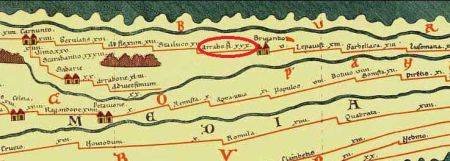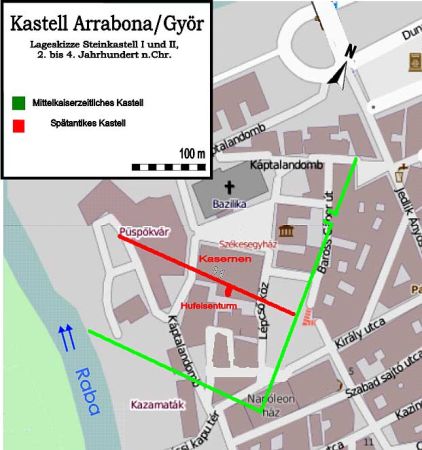Györ - The Archeological Meaning of Arrabonas
- Written by Portal Editor
In the area around Győr, once being the Roman military camp Arrabona, and along the Danube, traces of settlement of various cultures were detected earlier on.
A first major Celtic settlement on Káptalan Hill was built in the 5th century BC. The activities of Roman traders are to be noticed in Arrabona first time during the 1st century BC. At 10 BC the Romans also occupied the northern part of present-day western Hungary and added it into their expanding sphere of influence. After suppression of the great Pannon-Dalmatian rebellion in 9 AD, the province of Illyricum was divided. Its northern part fell to the newly established province of Pannonia.
In antiquity, the first Roman settlement of Arrabona were located in the area of Győr. The fort was one of the earliest Roman fortifications on the Pannonian Limes, auxiliaries of the army cavalry (Auxiliar) and, next to Klosterneuburg castle, the second auxiliary camp in Upper Pannonia with a crew of 1000 men. It was probably occupied with Roman troops from the 1st to the 4th century AD. In late antiquity, marines of the legions stationed in Vindobona and Carnuntum were partwise send to the fort. Findings of the fort and its surroundings bear witness to post-military use by the civilian population from the 5th century AD. Findings of the burial grounds provided a good impression of the decline of Roman culture and the increasing emergence of barbarian elements in a Limes fort at the time of migration of peoples.
Strategic meaning Arrabonas for Rome

The crew secured a busy river crossing on the Limes road (via iuxta Danuvium), at the section between Carnuntum and the legionary Brigetio and the terminus of an important diagonal road connecting the Danube with the towns of Savaria (Szombathely), Mursella, Sopianae (Pécs) and Tricciana far into the interior of the province. There existed a ferry service between the town of Vének and the south bank of the Danube until the Middle Ages.
Archaeologists and researchers on the Káptalan hill

A small part of the late antique south wall of the fort was conserved in the Bishop's Park and made accessible to the public as part of an archaeological viewing area.
Transdanubian "barbarian peoples" invade
At the same time, the conditions for the formation of the Upper Pannonian Limes had been created. During this period, according to an inscription, the fort became the residence of a praefectus ripae Danuuii et civitatum duarum Boiorum et Azaliorum. In the early 2nd century, the wood-earth fort was demolished by the ala I contarorium milliaria and rebuilt in stone construction. It was next to the castle in Klosterneuburg the second auxiliary camp of Pannonia superior, in which a crew of more than 1000 men was placed; such units were an important combat and power potential for their respective commanders. Between 166 and 167 AD, Marcomanni and Quaden crossed the Danube again and pillaged the Pannonian territories. The attack could be fought off, inter alia, with the help of the Aruba group of cavalries, but these actions were just a first taste of coming, much more devastating incursions of the trans-Danubian barbarian peoples.
In the reign of Constantine I, the camp was scaled down, but much more fortified. Rome was able to maintain its rule over the region until the late 4th century. The regular Roman military finally withdrew from Arrabona, presumably in the years around 380, whereupon the fort turned into a civil oppidum, in which the inhabitants of the fort and vicinities found shelter from the turmoil of the migration of peoples. The last Roman coin finds in the castle date from the time of Valentinian I and his brother and regent of the East, Valens. With the contractual handover of Pannonia to the Huns between 406 and 433 AD, the Roman administrative structures dissolved in Upper Pannonia. Despite constant threat of new immigrant tribes from the east, the castle remained inhabited throughout these years.
Around 500, Slavs and Lombards immigrated to the region. From 547 or 568, the Avars ruled the area around Arrabona until around 800. Later it came under Franconian and especially Slavic influence. Between 880 and 894 the place was part of the Great Moravian Empire and then briefly fell under East Frankish dominance for a short time. Around 900, the Magyars occupied Arrabona and incorporated the walls of the Constantine fort into the town fortifications. Stephen I, the founder of the Kingdom of Hungary, elevated the aspiring city to a bishopric. Since then it has been known under her Hungarian name Győr.
Please read as well:
Geographer Pomponius Mela and Lake Constance
Province of Noricum - trade route determined the progress